Production Notes - Diamonds
Are Forever
As the 1970s dawned, EON Productions found themselves
in something of a quandary. "On Her
Majesty's Secret Service"
(1969) had proved
less successful than EON had hoped [though it was far from the
financial disaster it's often damned as], George
Lazenby failing
to click with the viewing public as Connery had and EON were
faced with a crisis - Lazenby was clearly out, but who was going
to
replace him?
Of more immediate importance though was the
question of which novel was going to get the EON treatment next
- without a script
there was no point looking for a new Bond."Diamonds
Are Forever" was settled on as the title, though by the time
Richard Maibaum finished with it, there was precious little else
left of Ian Fleming's
original novel. Perhaps unnerved by a recent decline in the series'
fortunes, Maibaum originally opted to revisit past glories. His
first draft pitted Bond against Auric
Goldfinger's twin brother,
a Swedish shipping magnate whose bid for world domination was
aided by a super tanker fitted with a massive laser. Fleming's
diamond smuggling plot would be woven into the new narrative
with
Goldfinger trying to amass a stockpile of the gems to power
his super-laser.
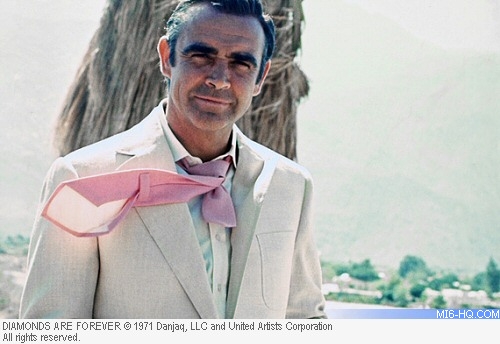
Above: Sean Connery in a publicity
shot on location in Nevada, USA.
|
Although Gert Frobe had remained in contact
with Saltzman and Broccoli [he'd appeared in Broccoli's adaptation
of Fleming's
Chitty Chitty Bang Bang (1968)]. he was unable to commit himself
to another Bond film and Maibaum was forced to rethink. Still
seeking to recall past glories, Maibaum wrote a second draft
that featured SPECTRE's head man Blofeld,
though he failed to appear
in Fleming's novel. The super-tanker idea was put on hold [it
resurfaced seven years later in "The Spy
Who Loved Me"] and was
replaced by a satellite that also used a diamond-powered laser.
|
Broccoli suggested one scene based on
a dream he'd had. The producer dreamt that he'd been reunited
with former employer Howard Hughes only to realise that
the multi-millionaire had been replaced by an imposter.
Broccoli mentioned the dream to Maibaum who used it as
the basis for the scene where Bond visits Las Vegas billionaire
Willard Whyte and discovers
that he has been replaced by Blofeld. Saltzman too made
his mark on the script, suggesting
Thailand and India as likely locations, though subsequent
logistical problems forced much of the extravagant Asian
action to be dropped [again it would be used later, in
"Octopussy" (1983)].
Maibaum appeared to be struggling somewhat
and United Artists vice-president Danny Reisner suggested
that a second screenwriter be brought in to help lick the
script into some sort of shape. Fellow UA executive David
Picker suggested Tom Mankiewicz, son of famed Hollywood scriptwriter
Joseph Mankiewicz. Mankiewicz Jr joined the EON team in Autumn
1970 and immediately set to work on the script. It was Mankiewicz
who added the scenes where Blofeld tries to evade capture
by Bond by fooling him with lookalikes, and the pre-credits
sequence where a vengeful Bond, still grieving the loss of
Tracy, tracks down what he thinks is Blofeld and kills him. |
|
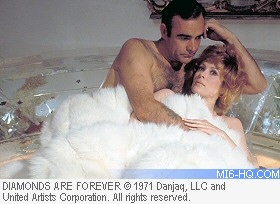
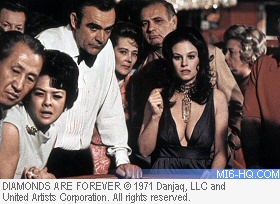 Above:
The leading ladies of "Diamonds
Are Forever" -
Jill St. John played Tiffany Case (top) and Lana Wood played
Plenty O'Toole. Above:
The leading ladies of "Diamonds
Are Forever" -
Jill St. John played Tiffany Case (top) and Lana Wood played
Plenty O'Toole.
|
Mankiewicz's draft was complete by January 1971 and was greeted
with some disdain by Maibaum, who was upset that his slam-bang
finale had been replaced by "an interminable thing on an
oil rig."
The script complete, Saltzman and Broccoli now
had to find a director. Peter Hunt, director of the previous
entry, "On Her Majesty's
Secret Service", was not an option - relations between Hunt and
his producers had broken down during the traumatic making of
Lazenby's
solo flight as Bond and Hunt had left the EON camp. Continuing
the endeavours to evoke the glories of past successes, Saltzman
and Broccoli called in Guy Hamilton, who had done such sterling
work on "Goldfinger" (1964).
|
Work could now begin on filling out the
supporting cast, though at this stage, it was still unclear
who exactly
was going to play Bond.
The majority of the cast would
be American, unsurprising given that the film was largely
to be set in the States. EON's Las Vegas based legal
advisor, Sidney Korshak suggested Jill
St John for the
part of Plenty
O'Toole and duly auditioned, apparently facing competition
from Raquel Welch, Jane Fonda and Faye Dunaway. St John
so impressed that he decided to cast her in the much
larger and more important role of Tiffany Case.
Plenty was eventually played by Lana
Wood, younger sister
of the better known Natalie Wood. Country and western singer
Jimmy Dean was brought in to play Willard Whyte while jazz
musician Putter Smith joined Bruce Glover as gay assassins
Kidd and Wint respectively.
Blofeld was to be played by Charles Gray who, confusingly,
had appeared in "You Only
Live Twice" as Bond's contact, Henderson.
The usual suspects were all brought back for their bi-annual
outing, Desmond Llewelyn, Lois
Maxwell and Bernard Lee all
rejoining the EON family, though not without some difficulties. |
|
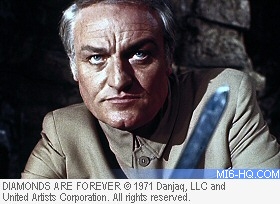
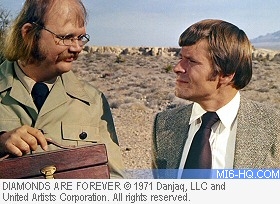 Above:
Charles Gray returned to the series, this time to play
Blofeld (top), with his two henchmen Wint & Kidd. Above:
Charles Gray returned to the series, this time to play
Blofeld (top), with his two henchmen Wint & Kidd.
|
Maxwell's agent demanded money
on the grounds that the few days she was required to appear in
the Bond films was getting
in the way of the rest of her career. Saltzman and Broccoli
refused to give way and told Maxwell in no uncertain terms that
she would be
replaced if she didn't tow the line. Maxwell did appear, but
spent most
of her on-screen time in a policewoman's uniform to help disguise
the fact that she'd dyed her hair black for a role in the Agatha
Christie thriller "Endless Night" (1971).
But as the supporting cast came into place, the big question
still remained unanswered - who was going to play James Bond?
Saltzman and Broccoli tried to woo George Lazenby
back into the fold by sending him a copy of the script for the
next film in
the series, "Diamonds Are Forever", but the reluctant Aussie
sent it straight back. He simply wasn't interested in donning
Bond's
tuxedo for a second time and was busy preparing for his latest
film "Universal Soldier".
Roger Moore,
who had been considered for "Dr No"
(1962) but who had been under contract as TV's The Saint at
the time, was again
briefly in the frame and Saltzman and Broccoli arranged screen
tests for a handful of less well known faces, among them future
Bond Timothy Dalton. For a
while it seemed as though the plum role had gone to naval intelligence
officer turned actor John
Gavin, who had appeared in "Psycho" (1960) and "Spartacus" (1960)
among many other films. In 1967, Gavin had appeared in "OSS 117
Double Agent", one of the many Italian spy thrillers that had
proliferated in the wake of EON's global success. Gavin was provisionally
offered the part and was given a 'holding contract' to keep him
on the hook.
|
But elsewhere, other plans were afoot. United Artists
were understandably nervous about introducing yet another
new Bond so soon after Lazenby and they determined that
the only man for the job was Sean Connery. UA executive
David Picker was unimpressed by Gavin and he was adamant
that Connery must return to the series, no matter what
the cost.
Associate producer Stanley Sopel called
on Connery while the star was staying at London's Dorchester
Hotel but came away only with Connery's second-hand Mercedes
[which the star sold to him!] but no interest in his return
to the series. Picker decided that the time had come to get
personally involved and flew to London to try to tempt Connery
with a new, unprecedented deal - $1,250,000 million in 18
weekly installments, 12.5% of the gross and a commitment
from UA to finance two non-Bond films of his choice. It proved
too much for Connery to resist and, against all the odds,
he signed on the dotted line. Although he would eventually
donate his fee to the Scottish International Educational
Trust [a charitable organisation for "the advancement
of education for the public benefit and the provision of
facilities for recreational and other leisure time facilities",
that Connery had formed in 1970 with industrialist Sir Iain
Stewart and racing driver Jackie Stewart], the deal still
made Connery the highest paid actor of his day. The real
James Bond was back. |
|
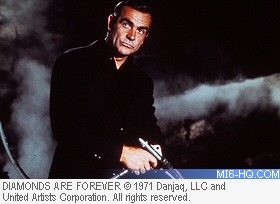
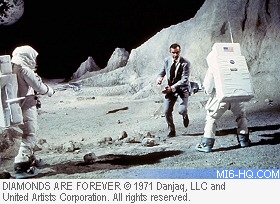 Above:
Sean Connery filming the pre-titles sequence, washing
his hands of Blofeld's plastic surgery goo (top), and
the surreal chase through the lunar training facility. Above:
Sean Connery filming the pre-titles sequence, washing
his hands of Blofeld's plastic surgery goo (top), and
the surreal chase through the lunar training facility.
|
With John Gavin compensated
to the tune of $50,000 [he carried on acting until he became
US ambassador to Mexico during the Reagan
administration], Connery was back in the EON fold and shooting
could at last begin. United Artists had come up with $7,200,000
by the time the cameras started to roll on Monday 5 April 1971
when the crew flew out Las Vegas to shoot preliminary footage.
Connery arrived on the 11th, full of plans to shoot a version
of "Macbeth" as part of the deal he had cut with United Artists.
In the first week of May, the second unit crew moved to the Nevada
desert to shoot the famous moon buggy sequence while Hamilton
and the main crew set up home at Oceanside, Palm Springs which
would double for Willard Whyte's palatial home. They also commuted
to Los Angeles where the International Hotel stood in for The
Whyte House casino and where the spectacular oil rig set was being
erected off the coast.
For the first time in the series, "Diamonds
Are Forever" also made use of other studio facilities, the crew
availing itself of Universal
Studios' north Hollywood backlot where they staged the car chase
through Las Vegas. As ever, the production racked up a lot of
air miles as it touched down in London, Dover and Southampton
in the UK; Amsterdam in the Netherlands; and the South of France.
But once again, EON's base of operations was
Pinewood Studios where the production arrived on Monday 7 June.
Ken Adam, back
in harness again after missing out on "On Her Majesty's Secret
Service", had worked his usual magic, taking over four of the
studio's
stages to recreate the film's main interiors. Principal photography
closed on Friday 13th August, smack on time, unlike "On Her
Majesty's
Secret Service" which had overshot by some two months.
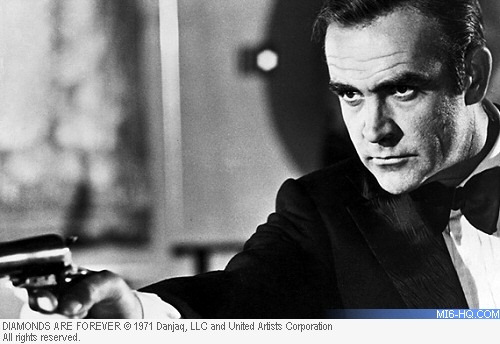
Above: Bond breaks in to Blofeld's
lair at the Whyte House in Las Vegas.
|
"Diamonds Are Forever" opened in the States
ahead of its British premiere, on 17 December 1971. It was an
immediate
hit, the return
of Connery to the fold rejuvenating a series that was hardly
ailing but which had certainly not been doing as well of late
as EON
might have hoped. Indeed in the States, "Diamonds Are Forever"
set a new Bond film record that would not be matched until another
rejuvenation, in the shape of "Goldeneye", in 1995.
The film opened at the Leicester Square Odeon
in London on 30th December and was again greeted with enthusiasm
by Bond fans, shattering
existing records. Ultimately, the film's world-wide gross would
be marginally greater than "You Only Live Twice", making it
the
most popular film in the series thus far.
But there were problems afoot in the EON camp.
Saltzman and Broccoli, who had been brought together only by
their desire to see Bond
on the big screen, had not been seeing eye to eye on many things
for some time. The situation was starting to come to a head
at
around this time and the producers started to work on the films
separately from this point. Much of the work on "Diamonds Are
Forever"
was undertaken by Broccoli and it would be down to Saltzman to
guide the next in the series, "Live
And Let Die" (1973).